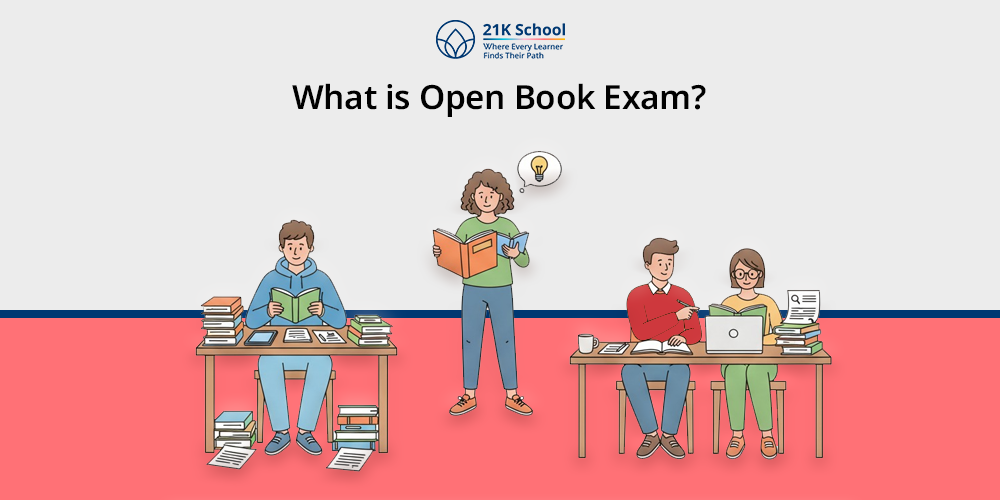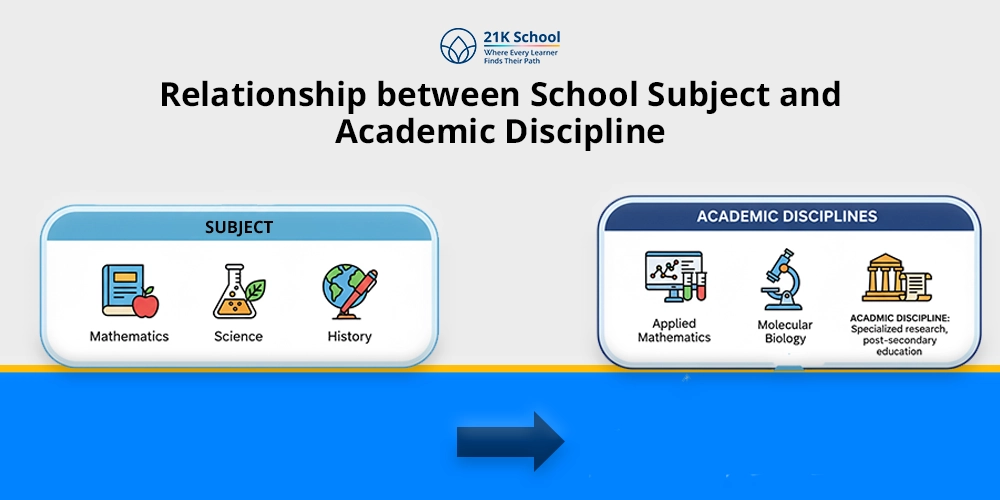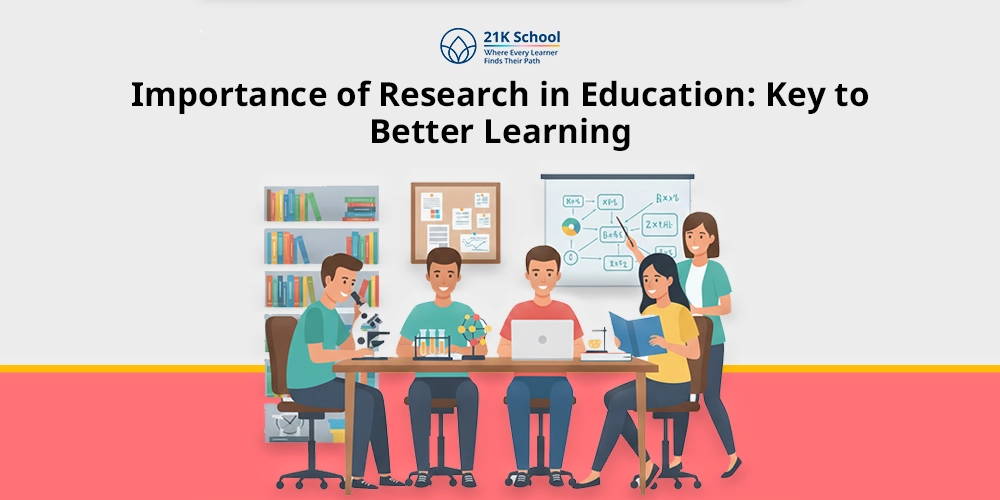
Did you ever wonder how open-book exams help students?
An open-book exam is a method of exam in which students give exams through an open book. In contrast to traditional exams where students give exams based on learned knowledge and memorisation.
In open book examinations, they find the answers to the questions in the book and write them in the exam paper. With the open-book exam children can read the contexts to get a better idea of the concepts.
But open-book exams look hard compared to traditional exams. Open-book exams also help children with problem-solving and creativity.
Even many government schools and boards like CBSE and State boards conduct open book exams.
Contents
What is an Open Book Exam?
In an open-book exam students may use any reference book or textbook during the test. It’s different from normal exams where you can look at nothing and just remember everything from memory.
The traditional exams are all rote learning , whereas open-book exams have students pick up the books and write down the answers.
Those exams are basically an opportunity to see if any students can think for themselves, problem solve and actually use what they have learned instead of just repeating facts.
Also, the CBSE board has started conducting open-book exams to assess students ‘problem solving ability and knowledge comprehension.
Types of Open Book Exams
Open book exams generally fall under two categories – restricted open book exams & free open book exams. Here are the types of open book exams mentioned below.
1. Restricted Open Book Exam
On restricted open-book exams students are given some pre-approved material – for example class books or class notes – but not guidebooks or personal notes or personal books, etc. Basically, it is a type of exam which tests how well you use the few references available.
2. Free Open Book Exam
A free open book exam is also called an unrestricted open book exam. In this type children are allowed to take any exam references such as guide book, personal note and so on. It is the type which deals mainly with problem solving and synthesis from big information bases.
How to Take an Open Book Exam?
Open-book exams let students take the exams by reading the books and understanding the concept rather than memorisation.
So students have to study well for the open-book exams and have to prepare some tactics for passing the exams. Here is how students take their open book exams.
1. Start with Easy Question
Take simpler questions first, to build confidence , score quick points & warm up, before students go for more complex ones. Always look for easy or known questions in exam papers and in the book.
2. Read Questions Carefully
Read each question carefully to understand requirements, key terms & avoid misinterpretation. Always check the questions with the book phrase and the keyword for the quick answer or reference.
3. See all the Keyword Answers
Search your resources for keywords from the question to find and confirm information fast. Your response should answer the question directly. This will answer some of the hard questions & save you searching for points in the books.
4. Watch the Main Lines of the Paragraph
As per exam question paper, read only the main paragraph, topic, sentences and headings and not every word. This saves time and students can look up the answers quickly along with that, it will help them in finding accurate information.
5. Verify all the Answers
Go back over your answers and make sure nothing was missed. That will allow last-minute revision and correction of mistakes if any.
Open Book Exam vs Closed Book Exam
Open book exam is different from closed book exam. Open book exams are stress free exams & closed book exams are just rote learning exams. Difference between open book and closed book exam are mentioned below.
| Aspect | Open Book Exam | Closed Book Exam |
| Definition | In an open book exam students read the book and write the questions in the exam paper. | It is a traditional method of normal exam where students write their exam by memorisation. |
| Flexibility | Open book exams let students write exams without stress or anxiety as it is flexible. | Closed book exams are rigid and students have to prepare well as it doesnt provide any flexibility. |
| Question Style | The question style of the open book exam is complex and asks from different sources. | The question style of the closed book exam is completely straight forward as the exam is based on memorisation. |
| Approach | The main approach is to allow students to connect with the content more deeply. | The main approach is memorisation and rote learning method, better for developing long term memory. |
| Stress | Open book exams are stress free and allow students to give the exam without any anxiety and hindrances. | Closed book exams have stress as students have to memorise in order to gain desired results. |
Advantages of the Open Book Exam
Children learn new things by taking open book exams. It is a type of exam that allows students to understand the concepts in real time. Some benefits of the open book exam are listed below.
1. Reduce Exam Stress
Open-book exams are less stressful than traditional closed-book tests where forgetting a fact can be fatal.
Having students have access to resources reduces anxiety about memorizing details and promotes problem-solving and critical thinking . All this reduces study stress , boosts mood & performance.
2. Enhance Learning Capabilities
They expect active engagement instead of passive recall of information as well as more abstract cognitive skills like analysis, synthesis & evaluation.
Students have to find information quickly – this helps them understand concepts & how to use knowledge in real life.
3. Promotes Students Autonomy
Open book formats let students select what resources to study and what to use on the exam.
This gives learners independence because they must organize their materials and make decisions without constant teacher support.
4. Build Study Habits
This is about managing time and prioritising information and reviewing during the course and not in last minute rushes.
Over time, they help with academic performance and proactive learning – study routines that help with ongoing success.
5. Learns from Mistakes
Students learn from failures if they review resources in real time or after an exam. That allows them to see what they have missed in learning.
And there is a growth mindset in this iterative process as well; Setbacks are chances to improve, making learners more resilient to experience.
6. Deeper Understanding
And open book tests make you understand rather than just repeat what you know – which is good for long term memory.
When things get stored up in higher-order thinking they become available for later critical thinking and intellectual development tests.
Disadvantages of an Open Book Exam
Open book exams allow access to resources but are seriously flawed in terms of learning outcomes and assessment integrity. These are the limits of an open book exam.
1. Limited Knowledge Retention
On open book exams students may do quick lookups instead of internalising key concepts. And if learners do not have to memorise, they may not do the repeated spaced or deep processing that builds long term memory.
So a superficial understanding may then develop and students may find it harder to use knowledge in real life.
2. Difficulty in Assessing
Evaluation of student performance becomes more difficult in open book formats – it’s harder to tell the difference between real understanding and copying from materials.
As a consequence grading is subjective and takes time, and there may be inconsistencies or disagreements about fairness which undermine the reliability of assessments/the ability to measure true competency.
3. Lacks Thinking Skills
Although designed to foster critical thinking, open book exams can actually foster insufficient independence if students treat resources as crutches rather than tools.
That might eventually impair the development of core cognitive abilities such as logical reasoning and creativity, making students less prepared for situations where quick reference isn’t possible – for example, collaborative projects or new tasks.
4. Challenges in Time Management
There are no limits on resources so students will flit between pages looking for information, flipping through notes or checking details which will bog down the exam.
That means even very prepared students will fail because of inefficiency, stress and because they have more organised skills than most learners have.
5. Hampers Practical Application
Not even open book exams can simulate real life situations like when resources are not always available or when decisions have to be made quickly.
It might be that that limitation prevents practical knowledge development and problem-solving techniques , which are very important in real life.
Expert Insights and Research
Through the open book exam plan of CBSE & NEP critical thinking skills have been developed. It’s a break from rote memorisation and it is in line with National Education Policy (NEP) 2020 , National Curriculum Framework (NCF) 2023 and National Curriculum Framework for School Education (NCFSE) 2023.
In a pilot programme run by CBSE, open book assessment will start in 2026-27 academic session starting in 2026. This is done to reduce rote learning/memorisation and to create a stress free positive learning environment . It was a pilot project of professional educators conducted across various schools.
Educational Research Findings
Some problems are associated with switching to rote learning, according to education research. Time management, poor structure, biased discussion and no problem-solving are problems of the method.
But many students also said the exam is flexible and will ease exam stress and anxiety.
Student Success Statistics
In one of the surveys of the Students’ Perspectives of Open-Book Examinations, many students said that open book examination helps them. There had been open-based and traditional exams, and students had taken both the examinations.
Of those, 52.5% said they are comfortable with both exams. Most students 51.2% thought the OBE was better suited to evaluate cognitive text-based learning and 36.3% said it had been better suited to prepare them for real-world scenarios.
Ending Note
Opening up books is an attempt to move beyond rote memorisation towards critical thinking, problem solving, deeper conceptual understanding.
Although they have great advantages in terms of reduced stress, increased autonomy and real world application, they must be implemented with due care for knowledge retention and assessment fairness.
In case it is taken seriously, such an approach is able to help students get ready for information overload not only for examinations but for life.


